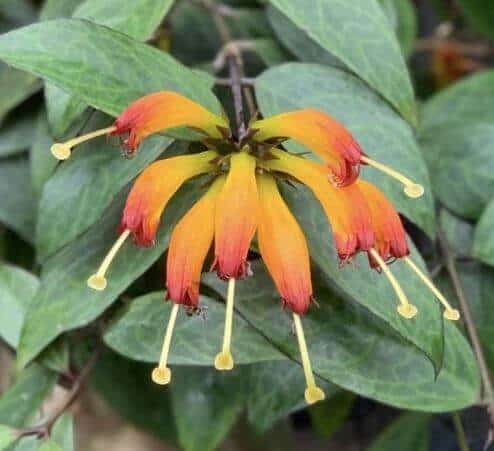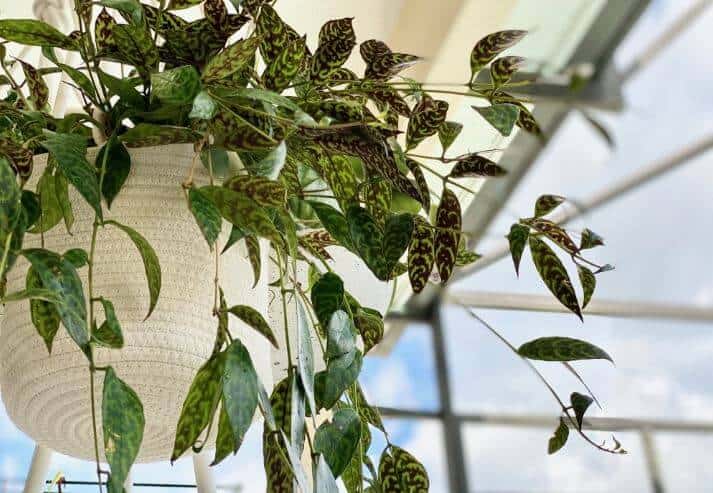Last Updated on January 5, 2023 by a Friendly Gardener
Also known as the Zebra Basket Vine, the Black Pagoda Lipstick Plant (Aeschynanthus longicaulis) is a gorgeous trailing plant with stunning shiny green leaves and striped purple-colored variegations.
This low-maintenance plant is very easy to care for and looks great in hanging baskets and planters. So, if you’re looking for information about the black pagoda lipstick plant and its care, then you’re in the right place.
Black Pagoda Lipstick Plant Characteristics

The black pagoda plant is a delicate-looking plant that resembles a Hoya. The evergreen epiphytic plant is native to tropical countries such as Malaysia, Vietnam, Thailand, and other Southeast Asian countries.
The medium-sized plant is popular for its cascading vines that can spread, climb, overhang or trail on windowsills, walls, and planters, making them suitable for hanging baskets or containers.
The black pagoda lipstick plant is characterized by its lance-shaped glossy leaves, which have a solid dark green-coloring mixed in with white variegation on the top and solid purple, maroon or pale green coloring on the undersides.
The leaves sometimes have zebra-like stripes, which gives the plant its name, “Zebra Basket Vine.” The black pagoda grows to a length of around 1.6 ft to 3.3 ft.
In summer and fall, the plant produces gorgeous 2-inch-long orange, red, or yellow-colored tubular flowers that appear from a burgundy-colored bud, giving them a lipstick tube-like appearance.
The black pagoda lipstick plant is a slow-growing plant and takes around 5-10 years to reach maturity.
Black Pagoda Lipstick Plant Care Guide
In this section, we’ll give you all the information about the black pagoda lipstick plant care.
Light
The black pagoda plant grows well and thrives in bright but indirect light for around 5 to 6 hours, which will enable it to bloom. If kept indoors, you must place the plant in a south or east-facing window, and it will grow quickly and bloom profusely.
If you notice that your plant has small leaves or does not bloom often, then it means that it needs more bright indirect light.
Avoid placing the plant in direct sunlight or locations that get more than two hours of direct light, as this can cause the plant’s leaves to get scorched.
Black pagoda lipstick plants do well when grown in artificial lighting and you can use grow lights providing 500 FC to 1000 FC of light.
Temperature and Humidity

The black pagoda lipstick plant thrives well at temperatures between 60°F and 85°F. The plant does very well indoors at room temperature.
The black pagoda plant is sensitive to frost, and any fall in temperature below 60°F can cause the leaves to turn yellow or drop.
If this occurs, then move the black pagoda plant into a warmer location. The plant is sensitive to sudden temperature changes, and it does not like drafts. So, avoid placing the plant near entryways, draft doors, and windows or air conditioning.
Black pagoda lipstick plants prefer humid conditions (around 60% to 70%), and with this amount of humidity in the air, the plant will produce larger and glossier foliage.
But the plant does well in dry conditions too. So, there is no need to mist your plant or provide a humidifier. Even if you live in an area with a dry climate, the black pagoda plant will still produce flowers in low-humidity conditions too.
Although if it is too dry, then it can result in browning of the leaf tip, crunchy leaves, and lackluster growth. The black pagoda lipstick plant does well in USDA Hardiness Zones 10 to 11, where it can be grown outdoors all year.
Soil
The black pagoda lipstick plant needs chunky soil that has good moisture retention but drains well. A well-draining soil will help to prevent root rot.
The best soil for your black pagoda plant is an aroid soil mix or you can use a soilless medium such as sphagnum moss or coco noir.
If you want to use a regular potting mix, then you can add around 50% of sand, perlite, or vermiculite into the mix. Adding some organic matter or compost can help to enrich the soil.
Watering

You need to be careful when watering your black pagoda lipstick plant because the plant is susceptible to root rot. Overwatering can also cause leaf shedding, yellowing and fungal problems.
The plant needs evenly moist, well-aerated soil but the soil must not be drenched or soggy. Wait for the top two inches of the soil to dry out completely before watering it again. Use the finger/stick test or a moisture meter to decide whether to water the plant.
You can bottom water the plant as this will allow your plant to absorb the right amount of water it requires. For this, fill a container that is larger than the plant pot with water.
Lower the pot with your black pagoda plant into the container with water and allow it to sit in the water for around 10 minutes. Check the soil. If the topsoil in the pot is not moist, then allow the plant to sit in the water for another 20 minutes.
Remove the pot, drain the excess water and place it back on the tray or plate. Reduce the frequency of watering during the winter months to mimic the plant’s dormancy period.
Fertilizing
During the growing months of the plant i.e., in summer and spring, the black pagoda lipstick plant requires to be fed twice a month. You can use a balanced houseplant fertilizer to feed your black pagoda plant.
Pests and Diseases
Black pagoda plants are generally not susceptible to pests but they can be attacked by pests such as scale insects, green aphids, whiteflies, mealybugs, spider mites, and thrips.
The plant is commonly affected by diseases including powdery mildew, root rot, leaf spot, and botrytis blight.
Repotting and Pruning

The black pagoda lipstick plant does not need frequent repotting. But you should repot the plant once in one or two years or if it becomes root bound.
Trimming and pruning your black pagoda plant prevents it from becoming straggly and unkempt. This gives the plant a fuller appearance and also helps to promote new growth.
Propagation
The black pagoda lipstick plant can be easily propagated by using stem cuttings.
Conclusion

The black pagoda lipstick plant with its eye-catching looks, gorgeous leaves, and stunning blooms is very easy to care for. These compact plants look great with the other plants in your home and are the perfect choice for apartments, offices, patios, and decks.


